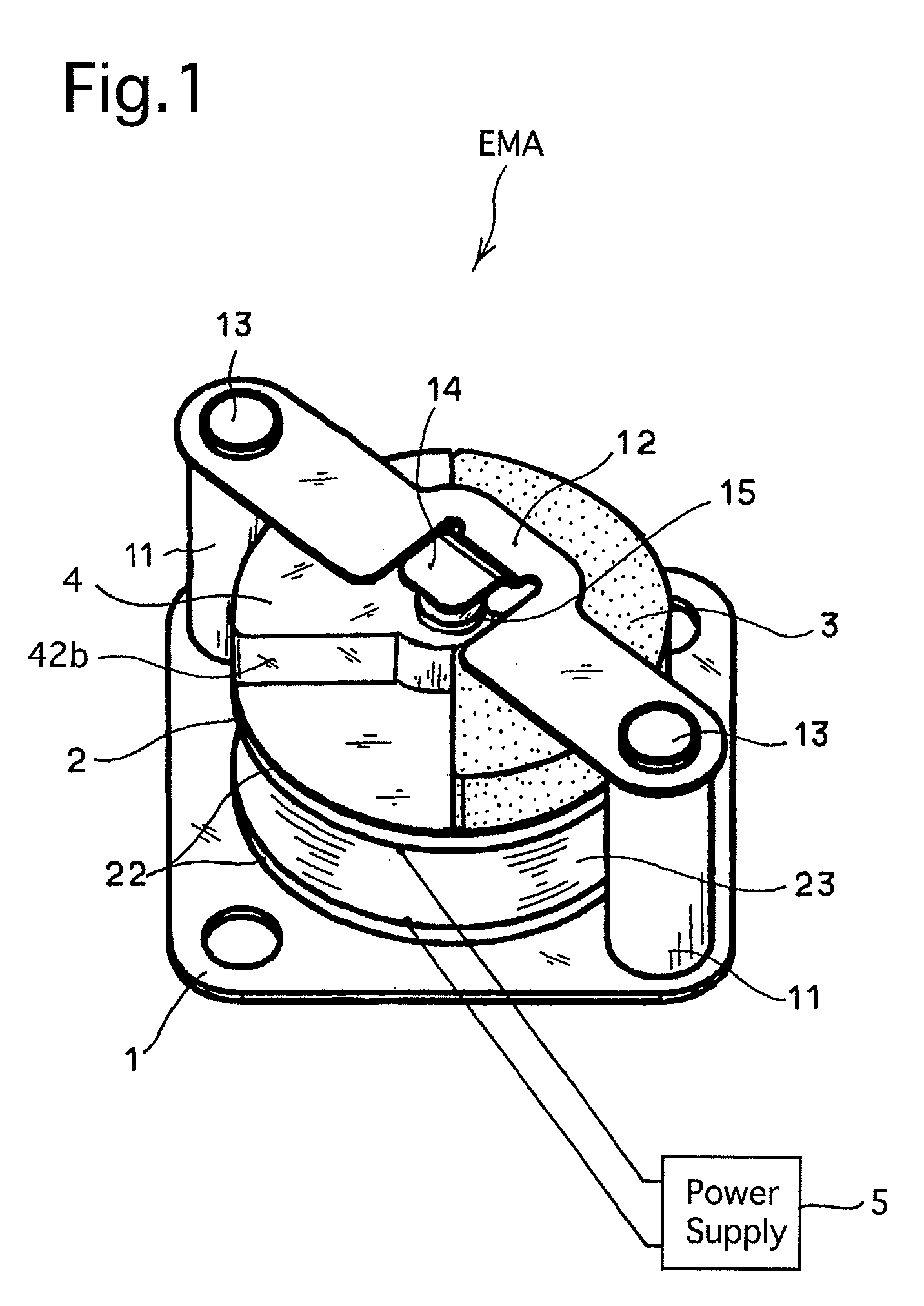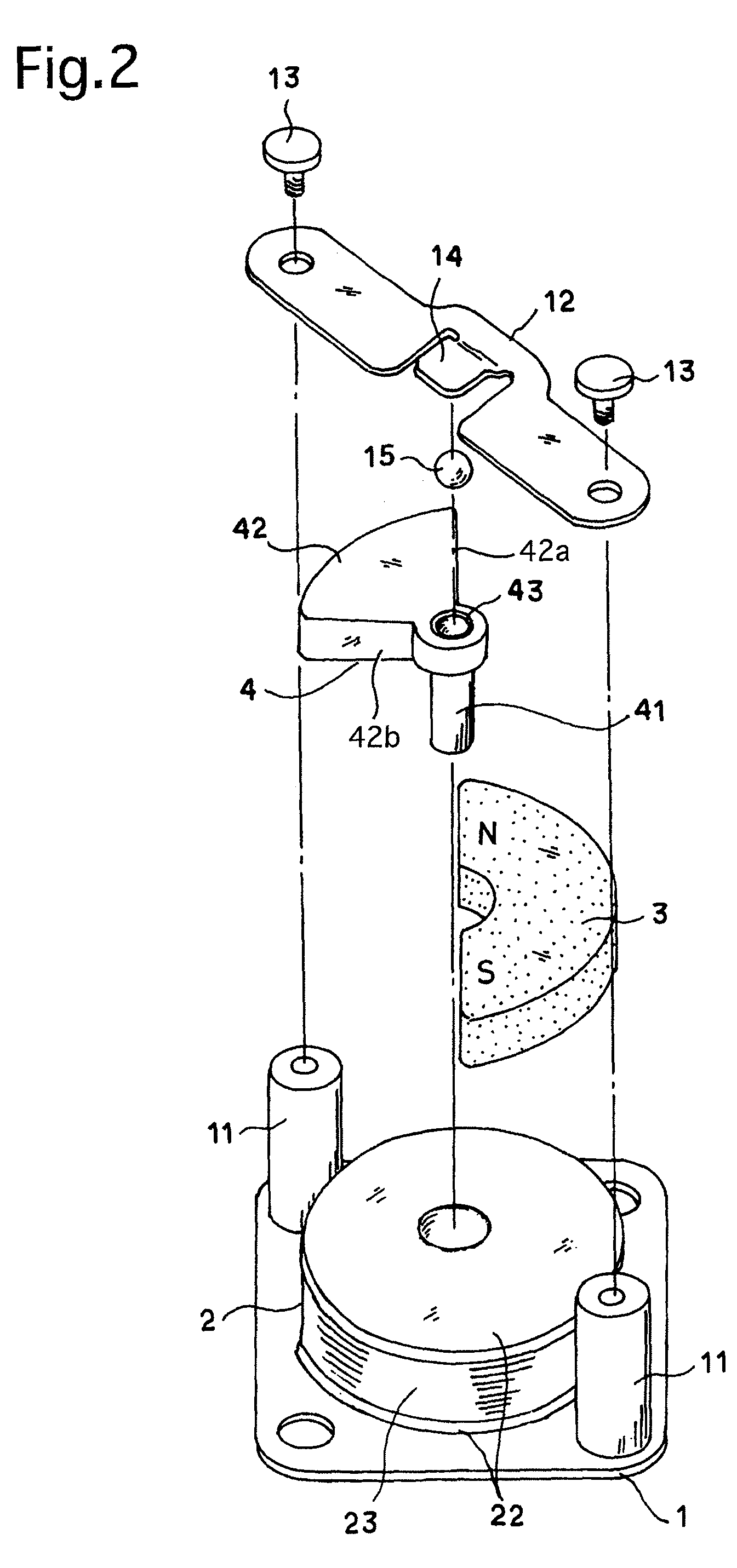Electromagnetic actuator
a technology of electromagnetic actuators and actuators, which is applied in the direction of magnets, magnetic bodies, instruments, etc., can solve the problems of reducing the miniaturization and weight of electromagnetic actuators, reducing the number of elements, and complicated determining the rotation range of the output shaft, so as to reduce the number of elements and reduce the weight
- Summary
- Abstract
- Description
- Claims
- Application Information
AI Technical Summary
Benefits of technology
Problems solved by technology
Method used
Image
Examples
embodiment 1
[0037]FIG. 1 is an external perspective view of an electromagnetic actuator EMA of Embodiment 1, showing the outward appearance thereof, and FIG. 2 is a perspective view of a portion of the electromagnetic actuator EMA. FIG. 3A is a plan view of a main part of the electromagnetic actuator EMA, and FIG. 3B is a cross sectional view taken along the A-A line shown in FIG. 3A. The electromagnetic actuator EMA is provided with a base (seating plate) 1, a cylindrical bobbin 2, a coil 23 and a permanent magnet 3. In these drawings, a cylindrical bobbin 2 made of a non-magnetic material, specifically an insulating material, is fixed onto the base (seating plate) 1 made of a substantially flat rectangular plate. The cylindrical bobbin 2 is provided at a center thereof with a hollow cylindrical portion 21, and is further provided, at the opposite ends of the hollow cylindrical portion 21 in the axial direction thereof, with two disk flanges 22, respectively. Clad wire is wound around the holl...
embodiment 2
[0045]FIG. 5 is a schematic diagram of an SLR camera CAM in Embodiment 2 that includes a mirror drive device MMD to which the electromagnetic actuator EMA according to the present invention is applied, showing the internal structure of the SLR camera CAM. The camera body 100 of the SLR camera CAM is structured so that a photographing lens 110 can be attached to the front of the camera body 100 and so that object light to be formed as an object image via the photographing lens 110 is reflected upward by a main mirror (quick-return mirror) 101 installed inside the camera body 100 to be formed as an object image onto a focusing screen 102 made of a transparent material such as glass or a plastics. The object image formed on the focusing plate 102 can be viewed by the user of the SLR camera CAM through a finder optical system 105 which includes an eyepiece lens 104, a pentagonal prism 103. At a time of exposure by a depression of a release button (not shown), the main mirror 101 is rota...
embodiment 3
[0053]FIGS. 8A, 8B and 8C show the shutter device SD of the SLR camera CAM in Embodiment 3 to which two electromagnetic actuators according to the present invention are applied, showing the structure of a vertically-traveling focal plane shutter. The shutter device SD is composed of focal-plane shutter blades 200 and a shutter blade drive mechanism 230. The focal-plane shutter blades 200 that are driven to open and shut a rectangular photographing aperture AP are positioned in front of the electronic imaging device PD of the SLR camera CAM as shown in FIG. 5 or in front of silver-salt film. The shutter blade drive mechanism 230 drives the focal-plane shutter blades 200. The focal-plane shutter blades 200 are provided with an upper set of shutter blades 210 and a lower set of shutter blades 220. The upper set of shutter blades 210 includes a first shutter blade 211, a second shutter blade 212 and a third shutter blade 213, and the lower set of shutter blades 220 includes a first shut...
PUM
 Login to View More
Login to View More Abstract
Description
Claims
Application Information
 Login to View More
Login to View More - R&D
- Intellectual Property
- Life Sciences
- Materials
- Tech Scout
- Unparalleled Data Quality
- Higher Quality Content
- 60% Fewer Hallucinations
Browse by: Latest US Patents, China's latest patents, Technical Efficacy Thesaurus, Application Domain, Technology Topic, Popular Technical Reports.
© 2025 PatSnap. All rights reserved.Legal|Privacy policy|Modern Slavery Act Transparency Statement|Sitemap|About US| Contact US: help@patsnap.com



